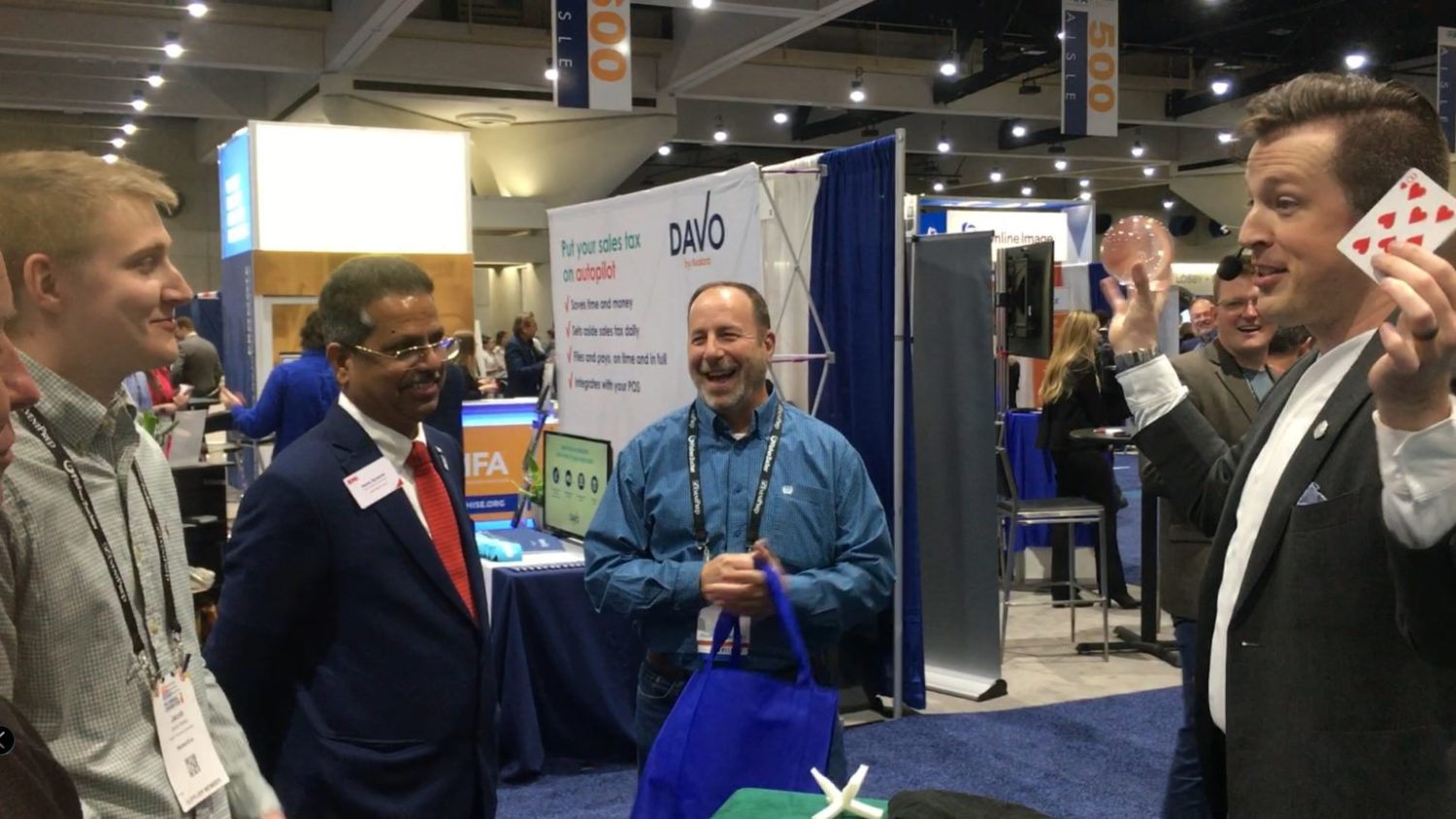Free iPads, prize wheels, and branded t-shirts can’t compete with a professional in-booth presenter in their ability to build a crowd, hold their attention, deliver your company’s marketing message, and smoothly transitioning that crowd to the sales team to close the deal.
And people never think of booking one!
We think that’s because most people don’t even know booth presenters are a thing. Seriously.
Most exhibit managers make the assumption that Company X is lucky to have a sales person who is such a “natural” at “this stuff.”
Turns out “this stuff” is the single most important factor between your company’s success or failure at the next show.
That’s why we wanted to make this list of common questions or comments about what a presenter is, what they do, how they do it, and why you should consider booking one.
Why Would You Use A Presenter?
More. Business.
It’s that simple.
Expert presenters are incredibly good at delivering your message to 10x or 15x the number of people that salespeople can do in a one to one, or one to two dynamic. A do it 2x an hour for hours at a time. They deliver the last presentation with the same energy and gusto as they had at the first presentation.
How? They love the work. Being in front of a crowd is like a shot of espresso every time.
What, Exactly, Is A Trade Show Presenter?
Someone highly skilled at getting attention, building a crowd, and holding their interest while they deliver an interesting experience that entertains as well as educates the audience.
They can be found standing in a booth talking with a crowd of people gathered around or speaking in a theater-style environment on a stage with a slideshow discussing the benefits & features of the company’s most recent offerings.
And they often do it two times an hour, every hour that the exhibit floor is open.
When done well, a trade show presenter is a seamless part of a company’s marketing strategy, and appears as though they are an employee of the company they’re representing.
This is rarely the case. They are most often an independent contractor or “mascot for hire” who has a long list of clients that they work with hopping from one trade show to the next representing a wide array of companies in many industries.
How Do Presenters Get Into This?
Most have a background in performance or public speaking of some sort.
They are used to being in front of a crowd, and are comfortable being the focus of attention for hundreds of people at a time.
They might already be a public speaker, corporate trainer, stage actor, celebrity* or on-stage personality of some sort who recognized their talents could be put to work helping companies communicate their marketing messages more effectively.
*We’ve seen Jack Hannah at a trade show. He had a pen with 3 baby cheetahs, and they were adorable.
What Does A Presentation Look Like?
Whether the presenter is a juggler, world class yo-yo expert, magician, or comedian, their presentations all follow the same fundamental pattern.
STEP 1: Build the audience.
A presenter needs people to present to, right? So the presenter will connect with one or two people who are walking past with an interesting question or low-pressure conversation starter.
Once two people stop, it’s easier to get two more. With four gathered, other attendees start to wonder “what’s going on over there?” and the presenter will invite them to gather closer to watch what’s about to happen.
Soon, there’s a crowd of 15 or 20 people, and now the presentation can begin.
STEP 2: Keep the audience.
Now the “show” begins. The presenter smoothly transitions from “audience gathering” mode into “marketing” mode.
When done right, this is a tightly scripted 10 or 12 minute presentation that will wow the attendees, make them laugh, and leave them “where did they find this guy?!”
Key marketing messages are woven into the presentation without being too obvious or “salesy” about it. Attendees will notice & remember the messaging without it being distracting or heavy handed.
There’s a strategic balance between messaging and entertainment that the presenter is a master at using to prequalify leads by explaining who this product or service is best suited to help.
STEP 3: Move the audience.
At the conclusion of the presentation, the attendees who are an ideal fit for the company is directed to the sales team who is ready to schedule follow up calls, scan badges, or whatever the proper “next step” in the sales process is.
The rest are thanked for their time and invited to pick up their free giveaway, or to grab some kind of promotional material on their way out.
This is all planned in advance and orchestrated between the presenter and the exhibit manager. When done right it’s a well-oiled machine that works 2x an hour all day long!
Who Uses Presenters?
The best.
DHL, the United States Postal Service, and thousands of other companies who recognize they need help bridging the gap between attendees and the messages they want to deliver.
They don’t “hope” people will stop by. They adopt a proactive strategy for connecting with attendees who they can help. A passive approach will lose every time.
They usually have a booth that’s big enough to accommodate large attendee flow. A 10×10 booth simply isn’t large enough to handle the kinds of crowds that an effective presenter can generate for their clients.
Service companies are an ideal fit for presenters. Without a product to demo, it can be difficult to generate interest with people who are walking by. A presenter, however, can be the human touch for the service you can’t see.
What Kind Of Value Is The Presenter Creating?
Start with the lifetime value of a new customer or client. Multiply that by the number of clients your company acquired at the last trade show.
Now multiply that number by 3.
That is the value that a presenter is creating for your company.
What Does A Presenter Cost?
You can expect to book an effective presenter for anywhere between $2,000 to $10,000 per day.
Presenters are essentially selling dates on their calendar, so it’s not really a service they’re selling by the hour. Also, they spend the weeks & months leading up to the show on lots of conference calls, writing scripts, designing custom presentation materials, and more. That time adds up.
Keep in mind, they work for themselves. They’re paying taxes, and all their expenses come straight out of their pocket.
While at first blush it might look like they’re charging too much, but weighed against the value the create for their clients, it’s a steal.
Can’t We Get Carl From Sales To Do This? He’s Funny.
This might be the most common question that we get in one form or another.
We get it. It makes sense to think your sales team is the best option for your trade show.
They’re not. Here’s why.
Think about how much money the company is investing in exhibiting at this trade show. 10,000’s of thousands of dollars in securing the booth space, the booth decoration, print materials, flying out the crew, and all the other million details that have to be managed.
That’s all on the line, and the three days of the show have to be worth it.
With all that on the line, nothing can be left up to chance.
Let’s run the numbers.
That team might, at most, do this 5x a year. A professional presenter? They are, easily, doing one show a week. That’s 52x a year.
A presenter has 10x more experience than the sales team does, and that difference gets bigger every year.
Your sales team won’t have the same presentation skills, confidence in front of an audience, familiarity with managing all the technology involved in a live presentation, calm under pressure when something (inevitably) goes wrong, and on down the list it goes.
Generating interest, gathering a crowd, entertaining them with just the right blend of humor and information delivery is not an easy skill to learn. It takes years of hard work and practice which your sales team will not have.
We can’t tell you how many times we’ve seen a salesperson spiral out of control due to tech failure, poor speaking skills, nerves, etc. and it can all be avoided by booking a professional presenter.
But the most convincing reason not to use the sales team? That’s not where they’re going to bring the company the most value.
The presenter starts the momentum, and the sales team will be right there to turn that into a meaningful 1:1 relationship with a high value prospect.
Also, the team can divide and conquer while the presenter continues to generate interest. They can listen to the keynote speakers who are experts in their industry.
(The presenter wouldn’t get anything out of listening to that speech; they’re not in that industry!)
But, a salesperson who is in the industry, might hear something that they can bring back to the team and make a huge impact on the company in the long run. If they were trapped in the booth, they wouldn’t be able to do that.
In short, the sales team is best served by doing everything but the presentation.
Takeaway
When you’re competing against the best of the best for the same opportunities, and there’s so much invested in these few days, it becomes more and more important for you to leave nothing up to chance, and team up with the best.









